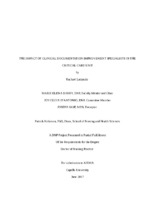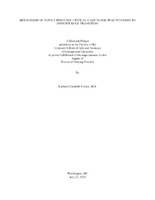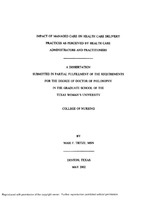| dc.contributor.advisor | Barry, Maria-Elena | en |
| dc.contributor.advisor | D'Antonio, Jocelyn | en |
| dc.contributor.advisor | Akif, Joseph | en |
| dc.contributor.author | Lattanzio, Rachael | en |
| dc.date.accessioned | 2017-08-08T21:18:42Z | |
| dc.date.available | 2017-08-08T21:18:42Z | |
| dc.date.issued | 2017-08-08 | |
| dc.identifier.uri | http://hdl.handle.net/10755/622511 | |
| dc.description.abstract | <p>Across the nation, hospitals are searching for a way to increase their case mix index (CMI), return on investment, and revenue from insurance companies. One of the most successful ways to enhance all three is by employing a clinical documentation improvement specialist (CDIS). Yet there are many factors that influence the success of a CDIS. This paper will follow the implementation and deduction of an eight-week CDI-program initiated in a critical care unit. The PICOT question posed is how does the implementation of a clinical documentation improvement specialist improve physician documentation and increase reimbursement in the critical care unit over an eight-week period? Through the methodical utilization of an access file to track and monitor queries, documentation inconsistencies, and trends, the CDI Specialist will be able to concurrently and positively impact the organization.<em> </em><em>CONCLUSION:</em> Over an eight-week period the CDIS was able to ensure $107,542.35 of which would not have been recuperated had the CDIS not been reviewing documentation for missing, inconsistent, or conflicting clinical documentation. Yet over this two-month time frame, the CMI was virtually unchanged. There are many things that inhibited the overall success of an increase in CMI, including administrative support, the participation of physicians with education and documentation, the <em>International Classification of Diseases- 10<sup>th</sup> edition (ICD-10)</em> coding guidelines, as well as the coders assigned to the organization, and time. The implementation of a CDI –program proved to benefit not only the organization financially, but improved quality improvement and physician documentation.</p>
<p class="APAHeadingCenter" align="left"><strong> </strong></p> | en |
| dc.format | Text-based Document | en |
| dc.language.iso | en_US | en |
| dc.rights.uri | http://creativecommons.org/licenses/by-nd/4.0/ | * |
| dc.subject | Documentation | en |
| dc.subject | Case Mix Index | en |
| dc.title | The impact of clinical documentation improvement specialists in the critical care unit | en_US |
| dc.type | DNP Capstone Project | en |
| dc.rights.holder | <p>
All rights reserved by the author(s) and/or publisher(s) listed in this item record unless relinquished in whole or part by a rights notation or a Creative Commons License present in this item record.
</p><p>
All permission requests should be directed accordingly and not to the Sigma Repository.
</p><p>
All submitting authors or publishers have affirmed that when using material in their work where they do not own copyright, they have obtained permission of the copyright holder prior to submission and the rights holder has been acknowledged as necessary.
</p> | en |
| dc.description.note | <p>This work has been approved through a faculty review process prior to its posting in the Virginia Henderson Global Nursing e-Repository.</p> | |
| thesis.degree.grantor | Capella University | en |
| thesis.degree.level | DNP | en |
| thesis.degree.year | 2017 | |
| dc.type.category | Full-text | en |
| dc.evidence.level | Other | en |
| dc.research.approach | Pilot/Exploratory Study | en |
| dc.subject.cinahl | Documentation | en |
| dc.subject.cinahl | Specialization | en |
| dc.subject.cinahl | Nursing Role | en |
| dc.subject.cinahl | Critical Care Nursing | en |
| dc.subject.cinahl | Health Information Management Personnel | en |
| dc.subject.cinahl | Case Mix | en |
| dc.author.details | Rachael Lattanzio, DNP, BSN, RN | en |
| dc.description.reviewtype | None: Degree-based Submission | en_US |
| dc.description.acquisition | Self-submission | en_US |





